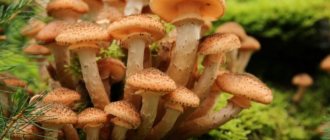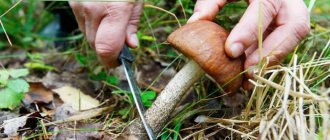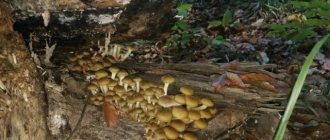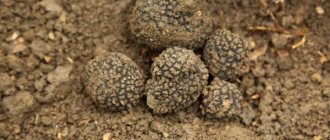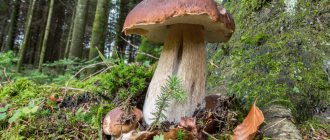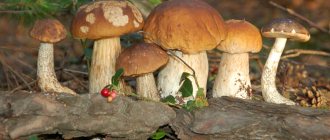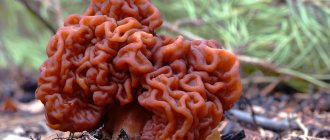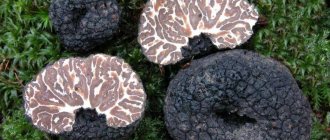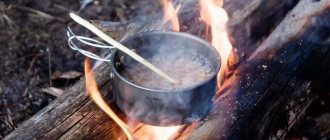The closer autumn is, the more mushrooms appear in the forest: already in August, mushroom pickers return from a “quiet hunt” with baskets full of everyone’s favorite boletus, boletus and boletus. August is rich in both russula and rednecks. Those who are well versed in forest gifts collect Polish, pepper and chestnut mushrooms, milkweeds, dung beetles, cobwebs and smoothies.
Lush nature in the form of trees, shrubs, and mosses provides many useful substances to mushrooms. In turn, many mushrooms contribute to the further prosperity of nature. This is their symbiosis. Although there are other examples where tinder fungi contribute to the destruction of trees and shrubs. However, scientists have determined that the initial process is their weakening, and only then the growth of fungi on them. This is the law of all nature. Plants, mushrooms, and fauna change and adapt to external conditions, and the weak and sick quickly die, often at the expense of other species.
You can find a description of the most popular types of mushrooms that grow in the Moscow region in August on this page.
Map of mushroom places in the Moscow region
Judging by the map of the Moscow region, you can go on a “quiet hunt” by train in different directions from the capital of our country: you can go both north and south, as well as to the east.
If you take the train at the Kazansky station, then it is better for mushroom pickers to go at the following stations:
Gzhel; Grigoryevo; Ignatyevo; Kuzyaevo; Shevlyagino; 73 km; Antsiferovo; Boletuses.
If you take the train in the Ryazan direction, you can get off at the following stops (but you should remember that you will have to walk several kilometers to the nearest forests):
Bronnitsy; 63 km; Faustovo; Sands; Konev Boy; Shchurovo;
Chernaya – at this station the coniferous forest begins immediately behind the platform. People come here for boletus and chanterelles. Lukhovitsy – in the forests located near the station, you can collect boletus and aspen mushrooms.
Rules for collecting mushrooms
Be extremely careful when hunting for mushrooms
When going to forest areas, it is important to know about the rules of conduct and safety. Regardless of the area and whether you are a mushroom picker alone or with company. The forests near Moscow are not overgrown, but it is also easy to get lost in them.
1. When caring for mushrooms, you should tell your family about the intended location. And don't go too far from this area. Set certain boundaries for yourself and stick to them.
2. Before leaving, you should add additional funds to your phone balance and fully charge the battery. Take water, a knife, a compass, matches or a lighter, and food with you. Even if you are not going for a long time, it is recommended to stock up on the minimum necessary things.
3. Dress in bright clothes. The camouflage color is difficult to see among the trees. It's better to wear something with reflective stickers.
4. You can’t go into the forests when it gets dark. Only during the day! It is important to remember the route taken. Fallen trees, clearings, ponds. Anything that will help when going back.
5. You can get lost in the forests of the Voskresensky district if you don’t know how to navigate. If this happens, you shouldn't panic. It's better to stop and look around. Remember landmarks and try to find them. It is better to find a road or clearing and walk along it. It will definitely lead to some populated area.
6. If you are forced to spend the night, you should not be afraid. It is necessary to light a fire from dead wood and warm up. Find a large tree and sit with your back to it. Light a fire right in front of you.
7. A mobile phone can help lost mushroom pickers. You need to call 112 and ask for rescue. Tell in detail about the location, describe all the nearby villages, villages, stations.
Irina Selyutina (Biologist):
When picking mushrooms, consider the following points:
- If you take children with you, wear only bright clothes - children should be visible from afar. They should always be in your field of vision, even from the side.
- Don't let children taste raw mushrooms.
- Before putting the mushroom in the basket, carefully inspect it: there should be no wormholes on its surface, the stem should be intact, and the plates should be light, but not white.
- Do not pull the mushroom out of the ground - cut or twist it to preserve the integrity of the mycelium.
- Do not collect edible mushrooms growing next to poisonous ones - spores that fall on their surface make them poisonous. The same thing happens when the mycelium of edible and poisonous mushrooms comes into contact.
- Pass by mushrooms that have a white sac covering them at the widened base of the stem - these are poisonous specimens.
- Do not pick old overripe mushrooms - leave them alone or hang the caps on a branch, this will improve the spread of spores by the wind.
If you don’t have a compass, then a quarter post, usually located at the intersection of the so-called block clearings. They have inscriptions - numbers located on all four sides. They serve as a kind of guide. The direction to the north will be indicated by the edge between the smallest numbers. The edge between the largest ones is, accordingly, to the south. Choose a direction and try to reach the next quarter post - as a rule, they are installed in straight lines that will lead you to the edge of the forest or populated area.
You can also find plotting posts in the forest. They are thinner than quarter ones and are equipped with a cheek directed towards the corresponding plot. They place them on its edge. The inscription on the pillar is represented in three lines:
- Quarter number – department number.
- The event is a year.
- Plot number – area (ha).
You are only interested in the top line. Provide this information to rescuers so that it can be passed on to forest guards. Then try not to go too far.
A rich mushroom harvest is expected in the Moscow region this summer
Last year, an official map of mushroom places appeared in the Moscow region, which was compiled by both foresters and mushroom picking experts who visit thematic Internet forums. Initially, 34 points were indicated on the map. This year the map was updated, adding 38 more. Of course, there are many more places in the region where you can indulge yourself in quiet hunting. But foresters say that the map is designed primarily not for local residents of villages near Moscow, who know all the mushroom clearings in the area without any hints, but for Muscovites and those who come to the forest from cities close to the Moscow Ring Road. These mushroom pickers, as a rule, walk through the forest blindly. And they plan the route so as not to waste a lot of time on the road. The hints on the map will be useful for them.
What mushrooms grow
Forests delight their visitors with a variety of mushrooms.
There is a beautiful fox in the Moscow region. She can be found near the Phosphorite Mine platform. In suitable weather conditions, the chanterelle grows from late August to October.
Near Konobeevo there are quite large families of honey mushrooms. Mushroom pickers fill baskets with them in 2-3 hours.
There are also boletus and aspen mushrooms there. They begin to gain strength only in mid-September. Weather permitting, you can enjoy picking until the end of October. These mushroom varieties flaunt throughout the Voskresenskaya district. There is no area where they are not found in the fall.
Capricious boletus also grows in large quantities in the forests of the Moscow region. Their activity has also been observed since mid-September. In addition, saffron milk caps, milk mushrooms, moss mushrooms, and kids grow.
Edible types of Chekhov's mushrooms
A lot of useful mushrooms grow in the Chekhov region. That is why summer residents and ordinary collecting enthusiasts flock here, even from neighboring cities. In the vicinity of Chekhov, the peak of growth occurs at the end of August - beginning of October. It is especially important that the weather turns out to be warm, then even until October, until the first hard frost hits, baskets of mushrooms are collected full in a few hours.
Material on the topic: How to pick mushrooms correctly so as not to damage the mycelium (spoiler: it is not necessary to twist them).
White mushrooms
Porcini mushroom (Boletus edulis) is a species of mushroom that belongs to the department Basidiomycetes, class Agaricomycetes, order Boletaceae, family Boletaceae, boletus. This is the most colorful representative of the mushroom kingdom in the Chekhov region. The abbreviated name of the mushroom is simply “white”, some call it boletus. According to nutritional properties, it belongs to the first category mushrooms. It grows in almost all forests from July until the first frost.
Boletus
Boletus is the common name of species belonging to the genus Leccinum. Almost all boletuses have a red cap, a stocky leg and dense flesh. Red boletus - (red mushroom, red mushroom, aspen mushroom, red head) is a fairly large representative of the mushroom kingdom. The mushroom cap can reach 30 cm in diameter. The first mushrooms appear in the vicinity of Chekhov from the beginning of summer (sometimes at the end of May, if the spring is warm and humid). They grow abundantly in the Chekhov region all summer and September, the last harvest is harvested in early October. The aspen grove near Chekhov, where I traditionally collect boletuses, rarely fails; they collect a lot of small and strong mushrooms.
Saffron milk caps
Camelina (spruce mushroom) is a general group of mushrooms belonging to the genus Milky. During the process of ripening, the cap becomes funnel-shaped (a distinctive feature of saffron milk caps). The shades of the cap range from light red to orange, but there are specimens with a bluish-green cap. The skin of the cap is smooth and sticky to the touch. This is a rather late mushroom - it appears in the Chekhov region in August and grows until the first ten days of November. The mushroom season of 2022 promises to be protracted; perhaps spruce trees will delight mushroom pickers until the end of autumn.
Milk mushrooms
The diameter of the milk mushroom cap is from 5 to 20 cm, the structure is dense, the shape of the young mushroom is flat-convex, then it becomes funnel-shaped, the edge is turned inward, pubescent. The skin is slimy, milky white or slightly yellowish with concentric zones. The color of the plates ranges from yellow to cream. Milk mushrooms, as well as saffron milk caps, belong to later specimens. They appear at the end of summer and grow until severe frosts and the first snow.
Volnushki and whitefish
The plates of the white or belyanka are adherent, descending to the stem, frequent, narrow, white in youth, then acquiring a creamy tint. The pulp is white, dense, strong, which allows the mushroom to be transported well over long distances. The taste is slightly tart, the milky juice is white, released abundantly, and does not change color upon oxidation.
The leg reaches 6 cm in height in an adult specimen. Ordinary moths are in many ways similar to white moths, only the color is more yellow, the leg is a little lighter and stronger than those of their white counterparts. The harvest of white mushrooms does not take long - the first mushrooms appear in early August, and in October they practically disappear.
boletus
Boletus is a mushroom belonging to the genus Obabaceae, family Boletaceae. The main difference between the mushrooms included in this group is the muted brown shade of the cap. They have a less thick stem and cap flesh. Boletus is a spring mushroom, the closest relative of the porcini mushroom; has good taste. It is widespread throughout Russia. In the woodlands of the Chekhov region it grows from the end of May to the first ten days of November.
Honey mushrooms
An edible mushroom of the strophariaceae family, the genus Kyneromyces, has many subspecies that grow from early spring until severe frosts. Summer honey mushrooms grow in large colonies mainly on deciduous trees, especially on rotten and damaged wood. In mountainous areas they grow on spruce trees. The caps are 3-8 cm, initially hemispherical, closed, then almost open, smooth from yellow to yellow-brown with a darker edge. The plates are pale clay-yellow, turning rusty-brown with age; in young mushrooms they are covered with a white or yellow film. The leg is hard, dense yellow-brown, 3-8 cm long, 6-12 mm thick with a whitish ring, covered below the ring with loose scales. The spore powder is rusty brown.
Autumn honey fungus, also known as true honey fungus (lat. Armillaria mellea) is a species of edible mushrooms of the genus honey fungus of the Physalacriaceae family. The largest harvest of these mushrooms occurs in September-October. Beautiful, rather fleshy caps 3-10 cm, initially hemispherical, then convex, matte due to small scales, yellow-cream, ocher-brown. At first the plates are yellowish-white, hidden under a blanket. Then the plates become ocher or brown. The legs are 5-10 cm long, 1-2 cm thick, with the remains of a cover in the form of a white ring under the cap. The flesh in the cap is whitish with a pleasant smell.
At the end of autumn and at the beginning of winter, mushroom pickers in the Chekhov region will be pleased with winter honey mushrooms - the mushroom has adapted to bear fruit during thaws in winter. You can observe under a microscope how, when the temperature rises above zero, the cells of its mycelium that burst during freezing grow together. It grows on dead and living tree trunks, as well as on the stumps of willow, poplar, birch and linden. Sometimes it can be found on coniferous trees.
Caps 2-8 cm, young ones - bell-shaped or convex, then prostrate, sticky, yellow-ocher or rusty-brown, with frequent white-ocher or white plates below. The legs are thin, velvety, without a ring, at first the color of the cap, not very hard, then they become dark brown or almost black and hard. The main distinguishing feature of the winter honey fungus is its hard, velvety leg. The intergrowths of its fruiting bodies look like fiery spots against the background of snow.
Edible honey mushrooms have many false and even poisonous counterparts. To avoid mistakes when collecting, take only those specimens that you are sure of. It will also be useful to familiarize yourself with the selection, which covers all the popular types of honey mushrooms and their doubles.
Mokhoviki
A mushroom with a cushion-shaped cap, 5-12 cm in diameter. The surface of the cap has brownish-chestnut shades. The skin is dry and velvety in young specimens; over time it becomes covered with a network of cracks, which is a distinctive feature of this species and gives it a resemblance to the variegated flywheel. Appears in Chekhov and its environs with established warmth in late June - early July, grows until the first frost, and is usually found until early October.
